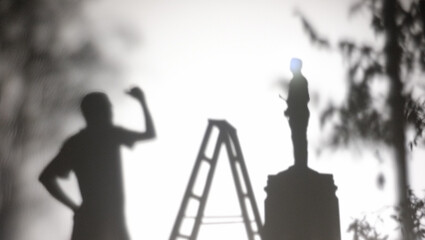Group Exhibition Guangdong Art Museum, Guangzhou
Since the past year, the need for us to come together and connect through “images” seems to have never been greater. The world, human beings and history are intertwined with each other. Having experienced acceleration and alienation under globalization we need to consider whether “images” can still serve as a viable path or way of thinking in the face of the current global situation given the long-term spread of the epidemic and the ongoing impact it has had around the world.
We live in a world heavily surrounded by images, and British art critic John Berger cannot help but lament that no form of society in history has ever seen such a concentration of images or such a density of visual information. In the book Camera Lucida, Roland Barthes mentions that the essence of the photographic image should be inter-factual presence rather than visual.
Under the rapid development of science and technology in this new era, coupled with the turbulent ecological conditions the existing modes of viewing visual imagery are constantly being deconstructed and reconstructed. The orienting quality of the image “this once was” will eventually break with the fast-paced progress of the times, which was once fixed at a certain moment in time for people and things within the photograph. In the section “Why Collectivity?” , the Hyperimage Group (Dong Bingfeng, Xiang Zairong, and Teng Yuning) invite artists, film directors, and other cultural practitioners to present in their own ways how people (including the interactions of people and non-people) come together with one another in different ways to reorganize spatio-temporal threads while adjusting and breaking the boundaries between the self and the social scene. “Frontier Mentality”, the section curated by Yang Beichen extends from the screen to explore the picture of technology—nature in an era of crisis—discussing the new frontiers of man and nature in the depths of time between the real and the imagined. Gerardo Mosquera curates “Globalscape”, a section that presents diverse representations of landscapes by contemporary photographers and video artists from different latitudes through different techniques and methods, beginning with scientific as well as other images from space.
The three sections of this exhibition explore the complex relationship between human beings, technology and ecology in an up-bottom, macro to the micro approach, addressing the past, present and future at various levels and in multiple dimensions. The exhibition also deals with the profound question of how to coexist between human beings as individuals and other species in the natural, physical and cosmic world we live in.
With the committed efforts of the Guangdong Museum of Art over the years, the Guangzhou Image Triennial has become a prestigious exhibition of contemporary art with both regional and global influence. Our goal is to establish a temporary “field” in the museum to connect the images of “memory”, nature and technology that "intermingle" here, in order to create possibilities for new dialogues.
We hope to use this opportunity to present our thoughts on the world we live in through the practice of video art. Finally, on behalf of the Guangdong Museum of Art, I would like to thank the Guangdong Provincial Department of Culture and Tourism for their guidance and the Guangzhou Image Triennial 2021 team who have worked hard day and night for this exhibition. The Guangdong Museum of Art will continue its research and exploration of the Guangzhou Image Triennial, and I sincerely thank all institutions and individuals for their continued interest and support of the Museum and the Triennial.
Wang Shaoqiang
Chief Director & Archival Exhibition Curator of Guangzhou Image Triennial 2021
Director of Guangdong Museum of Art
More Pictures:




































